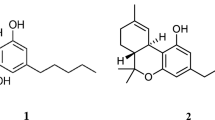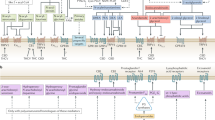Summary
Cannabis is the unique source of a set of at least 66 compounds known collectively as cannabinoids. Of these, most is known about the pharmacology of Δ9-tetrahydrocannabinol (Δ9-THC), the main psychoactive constituent of cannabis, and about cannabidiol (CBD), which lacks psychoactivity. Accordingly, this paper focuses on the pharmacological and therapeutic targets of these two cannabinoids. Many of the effects of Δ9-THC are mediated by cannabinoid receptors of which at least two types, CB1 and CB2, are present in mammalian tissues. Endogenous agonists for cannabinoid receptors have also been discovered. CB1 receptors are present at the terminals of central and peripheral neurones, where they modulate transmitter release. They also exist in some non-neuronal cells. CB2 receptors are expressed mainly by immune cells, one of their roles being to alter cytokine release. Δ9-THC also appears to have non-CB1, non-CB2 pharmacological targets. It is already licensed for clinical use in the U.S.A. as an anti-emetic and appetite stimulant and both Δ9-THC and Δ9-THC-rich cannabis extracts show therapeutic potential as neuroprotective and anticancer agents and for the management of glaucoma, pain and various kinds of motor dysfunction associated, for example, with multiple sclerosis and spinal cord injury. CBD has much less affinity for CB1 and CB2 receptors than Δ9-THC and its pharmacological actions have been less well characterized. Potential clinical applications of CBD and CBD-rich cannabis extracts include the production of anti-inflammatory and neuroprotective effects, the management of epilepsy, anxiety disorders, glaucoma and nausea, and the modulation of some effects of Δ9-THC.
Similar content being viewed by others
Abbreviations
- CBD:
-
cannabidiol
- THC:
-
tetrahydrocannabinol
References
Barann, M., G. Molderings, M. Brüss, H. Bönisch, B.W. Urban & M. Göthert, 2002. Direct inhibition by cannabinoids of human 5-HT3A receptors: Probable involvement of an allosteric modulatory site. Br J Pharmacol 137: 589–596.
Bayewitch, M., M.-H. Rhee, T. Avidor-Reiss, A. Breuer, R. Mechoulam & Z. Vogel, 1996. (–)-Δ9-tetrahydrocannabinol antagonizes the peripheral cannabinoid receptor-mediated inhibition of adenylyl cyclase. J Biol Chem 271: 9902– 9905.
Cravatt, B.F. & A.H. Lichtman, 2002. The enzymatic inactivation of the fatty acid amide class of signaling lipids. Chem Phys Lipids 121: 135–148.
De Vry, J., K.R. Jentzsch, E. Kuhl & G. Eckel, 2004. Behavioral effects of cannabinoids show differential sensitivity to cannabinoid receptor blockade and tolerance development. Behav Pharm 15: 1–12.
Dinh, T.P., T.F. Freund & D. Piomelli, 2002. A role for monoglyceride lipase in 2-arachidonoylglycerol inactivation. Chem Phys Lipids 121: 149–158.
Downer, E.J., M.P. Fogarty & V.A. Campbell, 2003. Tetrahydrocannabinol-induced neurotoxicity depends on CB1 receptor-mediated c-Jun N-terminal kinase activation in cultured cortical neurons. Br J Pharmacol 140: 547–557.
Drysdale, A.J., R.G. Pertwee & B. Platt, 2004. Modulation of calcium homeostasis by cannabidiol in primary hippocampal culture. Br J Pharmacol (Proc Suppl) In press.
El-Remessy, A.B., I.E. Khalil, S. Matragoon, G. Abou-Mohamed, N.-J. Tsai, P. Roon, R.B. Caldwell, R.W. Caldwell, K. Green & G.I. Liou, 2003. Neuroprotective effect of (-)Δ9-tetrahydrocannabinol and cannabidiol in N-methyl-D-aspartate-induced retinal neurotoxicity: Involvement of peroxynitrite. Am J Pathol 163: 1997–2008.
ElSohly, M.A., 2002. Chemical constituents of cannabis. In: F. Grotenhermen, E. Russo, (Eds.), Cannabis and Cannabinoids. Pharmacology, Toxicology and Therapeutic Potential, pp. 27–36. Haworth Press, New York.
Fowler, C.J., 2003. Plant-derived, synthetic and endogenous cannabinoids as neuroprotective agents: non-psychoactive cannabinoids, ‘entourage’ compounds and inhibitors of N-acyl ethanolamine breakdown as therapeutic strategies to avoid psychotropic effects. Brain Res Rev 41: 26–43.
Gallily, R., T. Even-Chen, G. Katzavian, D. Lehmann, A. Dagan & R. Mechoulam, 2003. γ-Irradiation enhances apoptosis induced by cannabidiol, a non-psychotropic cannabinoid, in cultured HL-60 myeloblastic leukemia cells. Leuk Lymphoma 44: 1767–1773.
Grotenhermen, F., 2002. Effects of cannabis and cannabinoids. In: F. Grotenhermen, E. Russo, (Eds.), Cannabis and Cannabinoids: Pharmacology Toxicology and Therapeutic Potential, pp. 55–65. Haworth Press, New York.
Guzmán, M., 2003. Cannabinoids: Potential anticancer agents. Nature Rev Cancer 3: 745–755.
Hampson, A.J., M. Grimaldi, J. Axelrod & D. Wink, 1998. Cannabidiol and (–)Δ9-tetrahydrocannabinol are neuroprotective antioxidants. Proc Natl Acad Sci USA 95: 8268–8273.
Hampson, A.J., M. Grimaldi, M. Lolic, D. Wink, R. Rosenthal & J. Axelrod, 2000. Neuroprotective antioxidants from marijuana. In: Reactive oxygen species: From radiation to molecular biology; Annals NY Acad Sci 899: 274–282.
Hanus, L., A. Breuer, S. Tchilibon, S. Shiloah, D. Goldenberg, M. Horowitz, R.G. Pertwee, R.A. Ross, R. Mechoulam & E. Fride, 1999. HU-308: A specific agonist for CB2, a peripheral cannabinoid receptor. Proc Natl Acad Sci USA 96: 14228–14233.
Herkenham, M., A.B. Lynn, M.R. Johnson, L.S. Melvin, B.R. de Costa & K.C. Rice, 1991. Characterization and localization of cannabinoid receptors in rat brain: A quantitative in vitro autoradiographic study. J Neurosci 11: 563–583.
Hillard, C.J. & A. Jarrahian, 2003. Cellular accumulation of anandamide: consensus and controversy. Br J Pharmacol 140: 802–808.
Hohmann, A.G., J.N. Farthing, A.M. Zvonok & A. Makriyannis, 2004. Selective activation of cannabinoid CB2 receptors suppresses hyperalgesia evoked by intradermal capsaicin. J Pharmacol Exp Ther 308: 446–453.
Howlett, A.C., F. Barth, T.I. Bonner, G. Cabral, P. Casellas, W.A. Devane, C.C. Felder, M. Herkenham, K. Mackie, B.R. Martin, R. Mechoulam & R.G. Pertwee, 2002. International Union of Pharmacology. XXVII. Classification of cannabinoid receptors. Pharmacol Rev 54: 161–202.
Hsieh, C., S. Brown, C. Derleth & K. Mackie, 1999. Internalization and recycling of the CB1 cannabinoid receptor. J Neurochem 73: 493–501.
Iversen, L.L., 2000. The Science of Marijuana. Oxford University Press, New York.
Iversen, L.L., 2003. Cannabis and the brain. Brain 126: 1252– 1270.
Jordt, S.-E., D.M. Bautista, H. Chuang, D.D. McKemy, P.M. Zygmunt, E.D. Högestätt, I.D. Meng & D. Julius, 2004. Mustard oils and cannabinoids excite sensory nerve fibres through the TRP channel ANKTM1. Nature 427: 260–265.
Keren, O. & Y. Sarne, 2003. Multiple mechanisms of CB1 cannabinoid receptors regulation. Brain Res 980: 197–205.
Maldonado, R., 2002. Study of cannabinoid dependence in animals. Pharmacol Ther 95: 153–164.
Mamas, M.A. & D.A. Terrar, 1998. Differential sensitivity to cannabidiol of the two components of delayed rectifier potassium current in guinea-pig isolated ventricular myocytes. Br J Pharmacol 123: 319P.
Marsicano, G., B. Moosmann, H. Hermann, B. Lutz & C. Behl, 2002. Neuroprotective properties of cannabinoids against oxidative stress: Role of the cannabinoid receptor CB1. J Neurochem 80: 448–456.
Martin, B., L.A. Stevenson, R.G. Pertwee, C.S. Breivogel, W. Williams, A. Mahadevan & R.K. Razdan, 2002. Agonists and silent antagonists in a series of cannabinoid sulfonamides. Symposium on the Cannabinoids, Burlington, Vermont, International Cannabinoid Research Society, p. 2.
Martin, B.R., B.F. Thomas & R.K. Razdan, 1995. Structural requirements for cannabinoid receptor probes. In: R.G. Pertwee (Ed.), Cannabinoid Receptors, pp. 35–85. Academic Press, London.
McKallip, R.J., C. Lombard, B.R. Martin, M. Nagarkatti & P.S. Nagarkatti, 2002. Δ9-Tetrahydrocannabinol-induced apoptosis in the thymus and spleen as a mechanism of immunosuppression in vitro and in vivo. J Pharmacol Exp Ther 302: 451–465.
Mechoulam, R., D. Panikashvili & E. Shohami, 2002. Cannabinoids and brain injury: Therapeutic implications. Trends Mol Med 8: 58–61.
Molina-Holgado, E., C. Guaza, J. Borrell & F. Molina-Holgado, 1999. Effects of cannabinoids on the immune system and central nervous system: Therapeutic implications. Biodrugs 12: 317–326.
Murphy, L.L., 2002. Hormonal system and reproduction. In: F. Grotenhermen & E. Russo, (Eds.), Cannabis and Cannabinoids: Pharmacology Toxicology and Therapeutic Potential, pp. 289–297. Haworth Press, New York.
Paton, W.D.M. & R.G. Pertwee, 1973a. The actions of cannabis in man. In R. Mechoulam (Ed.), Marijuana, pp. 287–333. Academic Press, New York.
Paton, W.D.M. & R.G. Pertwee, 1973b. The pharmacology of cannabis in animals. In: R. Mechoulam (Ed.), Marijuana, pp. 191–285. Academic Press, New York.
Pertwee, R.G., 1985. Effects of cannabinoids on thermoregulation: A brief review. In: D.J. Harvey (Ed.), Marihuana ‘84, pp. 263–277. IRL Press, Oxford.
Pertwee, R.G., 1988. The central neuropharmacology of psychotropic cannabinoids. Pharmacol Ther 36: 189–261.
Pertwee, R.G., 1991. Tolerance to and dependence on psychotropic cannabinoids. In: J.A. Pratt (Ed.), The Biological Bases of Drug Tolerance and Dependence, pp. 231–263. Academic Press, {London}.
Pertwee, R.G., 1995. Pharmacological, physiological and clinical implications of the discovery of cannabinoid receptors: An overview. In R.G. Pertwee (Ed.), Cannabinoid Receptors, pp. 1–34. Academic Press, London.
Pertwee, R.G., 1997. Pharmacology of cannabinoid CB1 and CB2 receptors. Pharmacol Ther 74: 129–180.
Pertwee, R.G., 2000a. Cannabinoid receptor ligands: Clinical and neuropharmacological considerations relevant to future drug discovery and development. Exp Opin Invest Drugs 9: 1553–1571.
Pertwee, R.G., 2000b. Neuropharmacology and therapeutic potential of cannabinoids. Addict Biol 5: 37–46.
Pertwee, R.G., 2001. Cannabinoid receptors and pain. Prog Neurobiol 63: 569–611.
Pertwee, R.G., 2002. Cannabinoids and multiple sclerosis. Pharmacol Ther 95: 165–174.
Pertwee, R.G., 2003a. Cannabinoids. In: C. Bountra, R. Munglani & W.K. Schmidt, (Eds.), Current Understanding, Emerging Therapies, and Novel Approaches to Drug Discovery, pp. 683–706. Marcel Dekker, New York.
Pertwee, R.G., 2003b. Inverse agonism at cannabinoid receptors. In: A.P. IJzerman (Ed.), Inverse Agonism, pp. 75–86. Elsevier, Amsterdam.
Pertwee, R.G., 2004a. Novel pharmacological targets for cannabinoids. Curr Neuropharmacol 2: 9–29.
Pertwee, R.G., 2004b. Pharmacological actions of cannabinoids. In: R.G. Pertwee (Ed.), Cannabinoids. Handbook of Experimental Pharmacology. Springer-Verlag, Berlin. In press.
Pertwee, R.G., 2004c. The pharmacology and therapeutic potential of cannabidiol. In: V. Di Marzo (Ed.), Cannabinoids, Kluwer Academic/Plenum Publishers, pp. 32–83.
Pertwee, R.G., 2004d. The therapeutic potential of cannabidiol. In: R. Mechoulam (Ed.), Cannabinoids as Therapeutics, Birkhauser Publishing, Basle, In press.
Pertwee, R.G. & G. Griffin, 1995. A preliminary investigation of the mechanisms underlying cannabinoid tolerance in the mouse vas deferens. Eur J Pharmacol 272: 67–72.
Pertwee, R.G., R.A. Ross, S.J. Craib & A. Thomas, 2002. (–)-Cannabidiol antagonizes cannabinoid receptor agonists and noradrenaline in the mouse vas deferens. Eur J Pharmacol 456: 99–106.
Pertwee, R.G., L.A. Stevenson & G. Griffin, 1993. Cross-tolerance between delta-9-tetrahydrocannabinol and the cannabimimetic agents, CP 55,940, WIN 55,212–2 and anandamide. Br J Pharmacol 110: 1483–1490.
Platt, B. & A.J. Drysdale, 2004. Search and rescue: Identification of cannabinoid actions relevant for neuronal survival and protection. Curr Neuropharmacol 2: 103–114.
Poling, J.S., M.A. Rogawski, N. Salem & S. Vicini, 1996. Anandamide, an endogenous cannabinoid, inhibits Shaker-related voltage-gated K+ channels. Neuropharmacology 35: 983–991.
Quartilho, A., H.P. Mata, M.M. Ibrahim, T.W. Vanderah, F. Porreca, A. Makriyannis & T.P. Malan, 2003. Inhibition of inflammatory hyperalgesia by activation of peripheral CB2 cannabinoid receptors. Anesthesiology 99: 955–960.
Thomas, A., R.A. Ross, B. Saha, A. Mahadevan, R.K. Razdan & R.G. Pertwee, 2004. 6″-Azidohex-2″-yne-cannabidiol: A potential neutral, competitive cannabinoid CB1 receptor antagonist. Eur J Pharmacol 487: 213–221.
Tomida, I., R.G. Pertwee & A. Azuara-Blanco, 2004. Cannabinoids and glaucoma. Br Ophthalmol 88: 708–713.
Ueda, N., 2002. Endocannabinoid hydrolases. Prostaglandins Other Lipid Mediat 68–9: 521–534.
van der Stelt, M. & V. Di Marzo, 2004. Metabolic fate of endocannabinoids. Curr Neuropharmacol 2: 37–48.
van der Stelt, M., W.B. Veldhuis, M. Maccarrone, P.R. Bär, K. Nicolay, G.A. Veldink, V. Di Marzo & J.F.G. Vliegenthart, 2002. Acute neuronal injury, excitotoxicity, and the endocannabinoid system. Mol Neurobiol 26: 317–346.
Whittle, B.A., G.W. Guy & P. Robson, 2001. Prospects for new cannabis-based prescription medicines. J Cannabis Ther 1: 183–205.
Zajicek, J., P. Fox, H. Sanders, D. Wright, J. Vickery, A. Nunn & A. Thompson, 2003. Cannabinoids for treatment of spasticity and other symptoms related to multiple sclerosis (CAMS study): Multicentre randomised placebo-controlled trial. Lancet 362: 1517–1526.
Zygmunt, P.M., D.A. Andersson & E.D. Högestätt, 2002. Δ9-tetrahydrocannabinol and cannabinol activate capsaicin-sensitive sensory nerves via a CB1 and CB2 cannabinoid receptor-independent mechanism. J Neurosci 22: 4720–4727.
Author information
Authors and Affiliations
Corresponding author
Rights and permissions
About this article
Cite this article
Pertwee, R.G. Pharmacological and therapeutic targets for Δ9 tetrahydrocannabinol and cannabidiol. Euphytica 140, 73–82 (2004). https://doi.org/10.1007/s10681-004-4756-9
Issue Date:
DOI: https://doi.org/10.1007/s10681-004-4756-9




